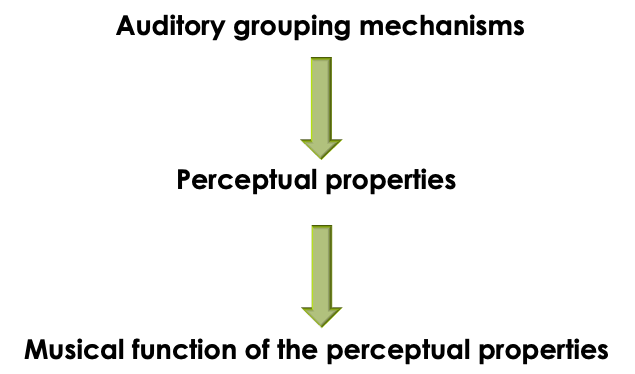TOGE | MTO — Example 8
Writings | Taxonomy of Orchestral Grouping Effects | Examples
Example 8. Timbral emergence (sustained, transforming): Schoenberg, Five Pieces for Orchestra op. 16, iii, mm. 1–11
Audio example 5 [recording of BBC Symphony conducted by Pierre Boulez, CBS Masterworks]
Score-following video
All Examples
Auditory grouping gives rise to events from which perceptual properties are extracted, which then acquire musical functions within a given sonic context
Auditory grouping processes and the resulting perceptual qualities and corresponding orchestral effects. [Adapted from Goodchild and McAdams 2021, Fig. 1]
Timbral augmentation (sustained, transforming): Wagner, Parsifal, Overture, mm. 20–25
Timbral augmentation (punctuated): Sibelius, Symphony no. 5, op. 82, iii, mm. 474–482
Timbral emergence (sustained, transforming): Schoenberg, Five Pieces for Orchestra op. 16, iii, mm. 1–11
Timbral heterogeneity (sustained, stable): Debussy, La Mer, iii, mm. 183–186.
Timbral heterogeneity (punctuated): Tchaikovsky, Nutcracker Suite, op. 71a, i, mm. 181–182
Stream integration (stable). Ravel’s orchestration of Mussorgsky’s Pictures at an Exhibition, vi (“Samuel Goldberg and Schmuÿl”), mm. 1–8, Score in C
Stream integration (transforming): Reynolds, The Angel of Death, S section, mm. 364–373; [From Touizrar and McAdams 2019]
Surface texture (transforming): Smetana, The Bartered Bride, Overture, mm. 89–99
Stream segregation (stable) of co-equal single-instrument lines: Vaughan Williams, The Lark Ascending, mm. 88–94
Example 18. Stream segregation (stable) of blended streams: Borodin, In the Steppes of Central Asia, mm. 210–218
Stream segregation (transforming) of blended streams: Stravinsky, Quatre Etudes, iv (Madrid), mm. 93–94
Stratification (stable) with three layers: Mahler, Symphony no. 1, ii, mm. 26–31
Stratification (transforming) in three layers: Borodin, In the Steppes of Central Asia, mm. 27–42]
Antiphonal contrast: Haydn, Symphony no. 100 in G major (Military), ii, mm. 61–64
Sectional boundaries: Dolan’s (2013b) orchestral graph of Haydn, Symphony no. 100, ii. Colors represent different instruments and the line thickness corresponds to notated dynamics.
Other analytical examples based on this work
Extremely rapid shifts in contrast
Timbral emergence (sustained, transforming): Schoenberg, Five Pieces for Orchestra op. 16, iii, mm. 1–11





























